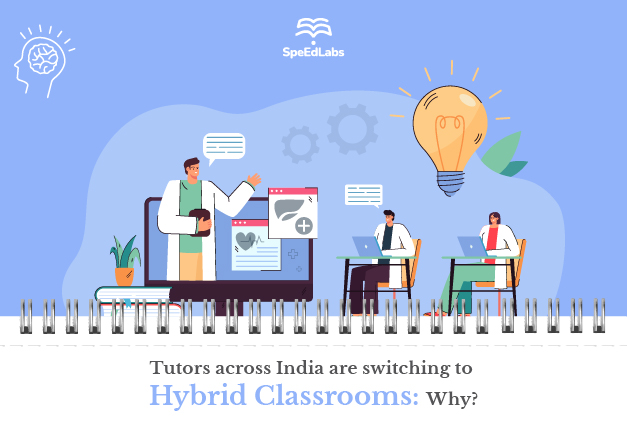The hybrid concept of learning is gratifyingly meeting the education system’s prospects at many levels.
Hybrid learning is a subordinate of blended learning which comprises both online as well as in-person classes. Recently, hybrid learning is in trend because of the ongoing corona pandemic. Most of you have studied more in conventional classes as compared to online ones but both of them are having their advantages and disadvantages.
Which among the two is best: offline or online?
One has to take care of several factors before opting for any type of classroom like for example, a very introverted person will prefer the online mode and on the contrary, a student who loves to interact with the community will go for an offline classroom. So how to decide the best option for yourself? Or are both important? In this blog, we will be discussing the type of learning format which is best for students and can go for both types simultaneously?
The most common confusion that many people face is that they think either of two is possible for a subject. It means a student cannot participate in both types of learning which is completely wrong. Hybrid learning is the learning of the future as this can provide an individual with comfort and flexibility of online courses with the support of teachers and classmates in offline mode.
Recently, the government has lifted the lockdown and many places are given permission to open again which includes educational institutions as well but the condition is to follow certain guidelines so that any sort of problem can be prevented like for example 50 % strength of students at a time, proper sanitization etc. Here comes the concept of hybrid learning. Colleges and schools are calling their students in the physical model for practical and laboratory purposes while theoretical classes are running in online mode only.
To achieve your educational goals, nothing can replace hybrid learning. But how? Let us understand the below-mentioned points:
- Classroom out of the physical classroom: When you are only following offline learning, you have to attend physical classrooms only that are bounded by fixed timings. But this is not the case with hybrid learning as using this, a learner can interact with his/her teachers whenever he/she wants. Moreover, you can interact with your classmates and that too with the comfort of your home. Apart from this, digital learning involves the active participation of the student whenever a class is held.
- Equality is imposed: With digital learning and pen-paper classrooms combined, everyone gets a chance to express himself/herself. While physical classrooms are dominated by extroverted students who actively participate in every discussion, question-answer round etc., online learning provides introverted students with a chance as well to express themselves and hence, every aspect gets covered in the discussion.
Not only this, some students are not comfortable with the English language as their mode of conversation and due to this such students often avoid interactions with their faculties, fellow batchmates etc. Online learning helps everyone to present themselves with thoughtful responses.
- A better understanding of concepts: One can’t compare two students in a classroom. Some students do not require any additional resources to understand the concepts while others face various troubles in the learning process. For example, Student A may have the potential of understanding organic chemistry without seeing any reaction in person while Student B can face trouble in processing the same reaction. Now offline mode is well suited when it comes to Student A as physical classrooms have certain limitations and animations and all can’t be played there. But Student B will choose digital learning because understanding here can be made less complex with the use of videos, animations and other software. This example very well explains the necessity of hybrid learning.
- Manageable time: With offline classes in action, students are under peer pressure of submitting assignments according to the professor’s or teacher’s wish. Not only this, but constant reminders can also build extra stress upon students which can ruin their mental and physical health. Hybrid learning is a bit different as in this a student manages his/her timetable and schedule with the help of a to-do list. This list can be made on a regular or weekly basis. To summarise, effective time management is imposed with hybrid learning.
- Cost-effective. Nowadays, tuition fees of almost all educational institutions are extremely high. Sometimes, it can impact the financial planning of an individual as well. But Kudos to hybrid learning as this is very cost-effective. This is because use of the institute’s resources like electricity, furniture etc. are reduced as online learning does not require any special arrangements except a system and internet connection.
Key Takeaways
Both offline and online classrooms are required for the overall growth of a student. Moreover, hybrid learning makes the best use of technology along with pen and paper to make learning more efficient and hence, it should be sure-shot implemented everywhere.
Also published on Medium.
